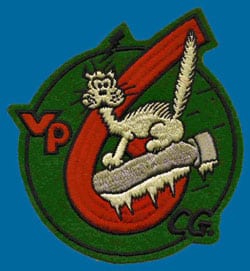 Since the beginning of the War in Europe the United States had been engaged in supporting Great Britain while technically remaining neutral. Cryolite, a substance used to extract metallic aluminum from bauxite ore, was obtained in quantity from a mine at Ivigtut. Greenland and was essential for aircraft production. When the British and Canadian governments expressed concern over the defense of Greenland, the United States, citing the Monroe Doctrine, undertook the task. In March of 1941 the Lend Lease Act was approved giving President Roosevelt almost unlimited freedom in directing military supplies to Europe without sacrificing U.S. neutrality. Construction on two air bases in Greenland to facilitate the ferrying of aircraft to the British was commenced at the same time. The Defense of Greenland was assigned to the Coast Guard due to its unique status outside of the War and Navy Departments and its experience in arctic operations.
Since the beginning of the War in Europe the United States had been engaged in supporting Great Britain while technically remaining neutral. Cryolite, a substance used to extract metallic aluminum from bauxite ore, was obtained in quantity from a mine at Ivigtut. Greenland and was essential for aircraft production. When the British and Canadian governments expressed concern over the defense of Greenland, the United States, citing the Monroe Doctrine, undertook the task. In March of 1941 the Lend Lease Act was approved giving President Roosevelt almost unlimited freedom in directing military supplies to Europe without sacrificing U.S. neutrality. Construction on two air bases in Greenland to facilitate the ferrying of aircraft to the British was commenced at the same time. The Defense of Greenland was assigned to the Coast Guard due to its unique status outside of the War and Navy Departments and its experience in arctic operations.
In June and July of 1941, the American forces congregating around Greenland were organized into the Greenland Patrol. The purpose of the Greenland Patrol as outlined by ADM Stark, the Chief of Naval Operations, was to:
- Support the Army in establishing airdrome facilities in Greenland for use in ferrying aircraft to the British Isles.
- Defend Greenland and specifically to prevent German weather observation operations in Northeast Greenland.
Greenland remained a Coast Guard operation throughout World War II. CDR Edward “Iceberg” Smith USCG was designated Commander Greenland Patrol which became task force 24.8. He would remain so during Greenland operations and was promoted in accordance with the increase in responsibility. In June of 1943 he was promoted to the rank of RADM and in November of that year he was given command of all of taskforce 24 which encompassed operations in both Greenland and Iceland.
Because of extremely limited Coast Guard aviation assets initial aerial support by Coast Guard aircraft was limited to J2F amphibians carried aboard those cutters equipped to handle them. Anti-submarine Patrols and search and rescue activities were carried out by Navy aircraft assigned to Commander task force 24.8. The initial Navy aircraft (PBY-5As) assigned to Smith’s operation, in the spring of 1942, were provided by VP-93 based out of NAS Argentia, Newfoundland. Six aircraft were retained at Argentia; three were deployed to Bluie West 1 (Narsarssuak) and three to Bluie West 8 (Sonde Stromfjord) on the west coast of Greenland. They were under operational and administrative control of Fleet Air Wing 7 (FAW-7). The mission was aerial coverage for convoys between Newfoundland and Greenland and the Greenland section of the North Atlantic convoy route to the British Isles. They also provided search and rescue support.
As Navy patrol squadrons transitioned to long range land based operations PBY-5As, which Smith considered essential for Greenland operations, were obtained from various sources. This evolved into a Greenland Air Group supported by VB-126 and Headquarter Detachments (HEDRON) under control of FAW-7. The area of responsibility encompassed Greenland, Labrador and the Canadian Arctic.
In early 1943 plans were in place for the transfer of FAW-7 to the European Theater of Operations. Air support in Iceland would become the responsibility of the British but the Commander US Atlantic Fleet wanted the Greenland area of responsibility to remain a Coast Guard function. It was planned to establish an all Coast Guard patrol squadron for Greenland operations. In June of 1943 the Commander of FAW-7, Captain William H. Hamilton, met with CAPT C.C. Von Paulson USCG who was SOPA at the time in the absence of RADM Smith. They discussed the coming Coast Guard aviation operation. Von Paulsen advised that the Coast Guard had the crews but not the desired PBY-5As.
On July 16 1943 orders were issued by C in C U.S. Fleet for the Coast Guard to organize a patrol squadron to operate PBY-5A aircraft. It was designated VP-6 (CG) and attached to FAW-7 for duty in Greenland, Labrador, and the Canadian Arctic. The first of the VP-6 (CG) personnel arrived at Argentia on 23 July and a training and indoctrination program was immediately initiated for pilots and crews using four PBY-5As transferred from HEDRON 7. Training consisted of qualification in aircraft type and a thorough familiarization with arctic flight operations. The Training program remained in continuous operation until 1 October. On 21 August 1943 VP-6 (CG) was established at Argentia Newfoundland, under FAW 7, CDR Donald B. MacDiarmid USCG, commanding. The squadron’s main mission was anti-submarine patrol and convoy coverage. On 13 October three PBY-5As assigned to the Bluie West One (BW-1) HEDRON detachment were relieved by VP-6 (CG) aircraft and air support became an all Coast Guard operation. Administrative control was transferred to FAW 9. All personnel matters however remained the responsibility of Coast Guard Headquarters.
Note:
An entry in the VP-6 (CG) War Diary dated August 1943 states that a Coast Guard PBY-5A #7243 was attached with personnel, with the reservation that the operational control of this aircraft remains always under Commander Greenland Patrol for duties as required. This was construed to mean that VP-6 (CG) would have an additional aircraft to authorized strength while operating under Commander Greenland Patrol, but if the squadron would be transferred to other duty by orders of FAW under which it operated this aircraft would remain with Commander Greenland Patrol. There was no further amplification except that this aircraft was apparently attached to Commander Greenland Patrol prior to the establishment of VP-6(CG) and was presumably located in Greenland at the time.
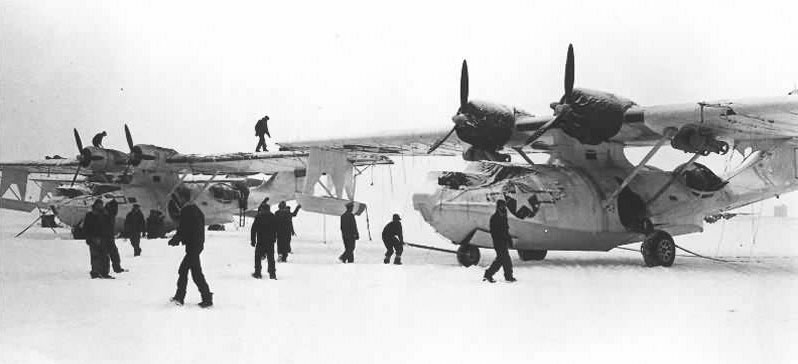
The squadron’s home base was BW-1. Initially there were six aircraft assigned plus CG PBY-5A #7243. The compliment was composed of 30 officers and 145 enlisted men; 22 of the officers were aviators and eight of the enlisted personnel were aviation pilots. The squadron mission was anti-submarine patrol; air support for convoys; search and rescue; surveying and reporting ice conditions; and delivering mail and supplies to military bases and villages. All of these missions were conducted in a hostile environment. The PBY-5A was well fitted for the duties assigned. It could carry a 2000 pound bomb load, or two torpedoes, or four 325 pound depth charges. The cruise speed of 105 knots and range of 2000 miles made it an excellent search vehicle. The amphibious capability was a definite asset. The drawback was that the aircraft were not heated and even with heavy winter clothing, cold and frostbite were problems.
Flying over thousands of miles of ice and open sea with few navigational aids was the norm. Strong winds over the ice cap of 120 knots were a constant threat. At BW-1, surface winds were rarely less than 25knots and the single runway had a considerable slope towards Narssarssuak Fjord. Landings were made uphill and takeoffs down hill. Under inclement weather conditions it was necessary to fly up or down the fjord at low altitudes to get in or out. There were 4000 foot mountains on each side and the pilots said it was like flying in a tunnel. John Redfield, one of the squadron pilots, said. “Most of the time, our return to BW-1 during bad weather conditions was an exercise in nail-chewing. We had very few instrument landing aids. Sometimes when we were inbound with one-quarter to one-half mile visibility we would receive a report that another plane had just departed BW-1 on a priority mission! After radar was installed in the PBYs navigation up and down the fjord became easier and safer. At the last turn to the west, if we could not see BW-1, less than a mile away, we would pull up and climb out.”
At BW-1 the squadron aircraft sat outside and all maintenance, refueling and arming took place in the open regardless of weather conditions. Moving the aircraft in and then out of a heated hangar caused condensation resulting in subsequent freezing in fuel pumps, controls, and instruments. Herman Nelson F-1 portable heaters were used to warm the engines and aircraft interiors prior to starting.
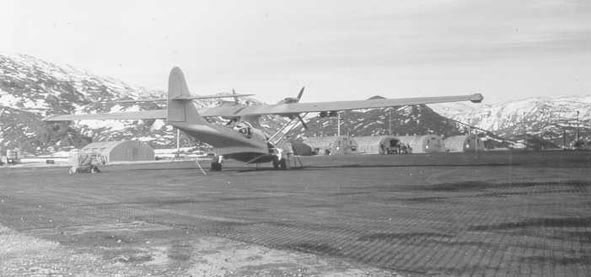
In December of 1944 six aircraft were replaced by new PBY-5As direct from Consolidated’s San Diego plant. Three additional aircraft arrived by the end of March. Five aircraft operated under operational control of Commander Greenland Patrol. Two planes were assigned to ice observation and two were in Argentia for operations and maintenance. All squadron aircraft rotated through Argentia for maintenance. With the coming of summer operations were expanded.
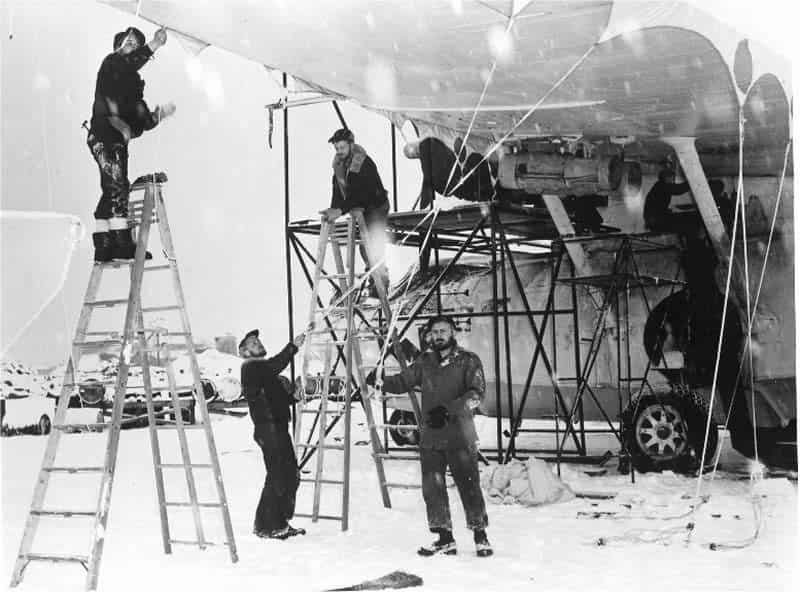
On 15 May CDR William I. Swanston, USCG relieved CDR D.B. MacDiarmid as Commanding Officer of VP-6 (CG). The authorized strength had been raised to twelve aircraft but three of these were retained at Air Station Elizabeth City for training of replacement crews. The rapid expansion of Coast Guard aviation produced a shortage of experienced pilots. A pre-training syllabus was set up at Elizabeth City to provide initial training for newly assigned VP-6 (CG) crews. Relief of personnel was staggered over a four month period to permit absorption and orientation training for replacements without disrupting operations. In July of 1944 two aircraft were deployed to the Canadian Arctic, Crystal-1 and Crystal-2, to provide ice reconnaissance and provide air cover for vessels operating in the Hudson Bay, Hudson Strait, Frobisher Bay and off the Coast of Labrador. The detachment returned at the close of the navigational season having flown over 400 hours on this assignment. Convoy support and ice observation also showed a marked increase during the summer months. As an example; LT. Carl H. Allen’s record shows he flew more than 100 hours a month during this period.
The detachment at Argentia was increased to three aircraft and VP6 (CG) was redesignated as VPB-6 (CG) in October. During the period from mid July to 16 November 1944, two PBY-5As and their crews, under the command of LCDR G.R. Evans, were sent to RAFB Reykjavik Iceland to provide ASW sweeps, ice reconnaissance and support of four Coast Guard cutters engaged in thwarting German efforts to establish weather stations in northeast Greenland.
During February of 1945 the installation of AN/APS-3 radar and AN/APV-4 LORAN in squadron aircraft began. Germany surrendered in May and U-Boat activity ceased. However VP-6 activity in search and rescue operations, ice reconnaissance, logistic support and LORAN station supply continued unabated and the squadron remained very active. Enroute aircraft traffic across the Atlantic picked up considerably.
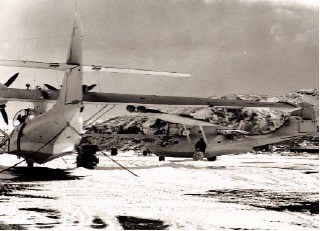
Squadron entries for May 22, 1945, reflect operations for this period: PBY-5A #46575 departed BW-1 in the early morning to survey ice conditions along the west coast of Greenland. Enroute passengers were landed at Ivigtut. PBY-5A #46458 returned to BW-1 with passengers and mail from BW-8. At 0800 the Army advised VPB-6 (CG) that a B-24 headed for Iceland from Goose Bay Labrador was in distress with two engines out. PBY-5A #46372 responded immediately and within an hour the B-24 was contacted and escorted safely to BW-1. PBY-5A # 46372 was refueled and departed again on ice surveillance. A chart depicting the information was dropped at Ivigtut to assist a convoy scheduled down the Davis Strait. On return to BW-1 information was received that an Army B-17E enroute to Goose Bay from Iceland was in distress with two engines out and the third running rough. Intercept was made and the B-17 was escorted up the fjord to BW-1. The third engine quit while landing. Lt. Allen in PBY-5A #46410, departed with passengers enroute Stephenville, Newfoundland. On his return flight he was directed to search for another Army B-24 reported down near Port-au-Choix. Allen located the downed aircraft on the beach, He then landed the PBY-5A in the water nearby, picked up the downed crew and flew them safely to Stephenville.
On May 30 1945 CDR Loren H. Seeger, USCG relieved CDR Swanston as commanding officer. In a letter dated 30 May 1945 it was suggested that the
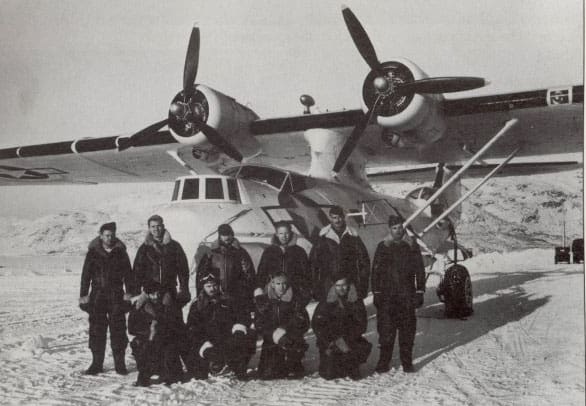
squadron be redesignated as a non-combat operating squadron in order that combat equipment could be removed from the aircraft and replaced with more suitable rescue equipment. In June the authorized complement was reduced to six aircraft and one operational spare. The reduction was accomplished by transferring the PBY-5A aircraft to Coast Guard air stations in the United States. On 12 July, administrative control of VPB-6 (CG) was transferred from Commander FAW-9 to the Commandant U.S. Coast Guard and it was redesignated a non-combat squadron. Operational control remained with Commander Task Force 24.0. Two PB4Y-1 aircraft were assigned for ice reconnaissance test work with AN/APS-15A radar. In August VPB-6 (CG) was directed to transfer its headquarters from BW-1 to the Naval Facility at Argentia. The Coast Guard was returned to the Treasury department on 1 January 1946. VPB-6(CG) was disestablished as a Navy Squadron at that time. Elements of the squadron would continue as an air detachment which operated as part of the North Atlantic Ocean Patrol (NORLANTPAC). 1944 – Air Detachment Annette Island Alaska Established:In the years leading up to World War II the thought was that any major operations by an enemy in the Alaska-Aleutian area was highly improbable. By April of 1940 the anxiety level had increased and it was concluded that there was a need for development of permanent installations at Kodiak, Sitka, Unalaska, Anchorage, and Fairbanks. Traffic through ports on the Pacific coast became extremely heavy. At Seattle in particular, facilities were stretched to their limits, and the American forces began discussions with Canada for using Canadian ports for shipment of troops and materials to Alaska. The build-up also required improved air service between the States and Alaska. In order to provide for larger and faster aircraft an airport with runways was needed as a refueling station between Seattle and Anchorage. Annette Island, a flat boggy island of about ten square miles, located twenty-five miles south of Ketchikan, was chosen as the site for a ten-thousand-foot runway. Construction started in the fall of 1940 and the first aircraft landed on the not-quite- complete runway in September of 1941. An important American embarkation port and ammunition dump was opened at the port of Prince Rupert, Canada in April 1942 but Canada’s ability to defend it against attack was very limited. The air base at Annette provided a location for defensive air support. Canada offered to supply a squadron of fighters to Annette, and by May 5, 1942, No. 115 (Fighter) Squadron was in place, becoming the first Canadian force ever based in U.S. territory to directly assist in American defense. Annette Island became a transit base for aircraft being relocated throughout Alaska. On June 3, 1942, a large carrier-based Japanese force attacked Dutch Harbor, and resulted in a huge increase in activity. Air traffic at the Annette base became quite heavy at times, with C-47 transports, Canadian PBY-5 Cansos, Bristol Bolingbroke bombers, Norsemen utility aircraft, and P-40 fighters. A U.S. Coast Guard Aviation Detachment was established at Annette Island on 14 March 1944. It consisted of two pilots, five enlisted crew members, and one Grumman JRF amphibian. Personnel were billeted in the Civil Aeronautics Administration (CAA) Quonsets. The CAA provided hangar and office space. At the end of the war the several commercial airlines including Pan American resumed expanded operations.In June 1946 a second JRF, pilot and crewmen arrived. In November of 1947 a PBY-5A was assigned, however PBY operations were discontinued in March of 1948. In the fall of 1952 UF-1G Albatross aircraft replaced the JRFs and the number of assigned personnel assigned to the Air Detachment increased. Ownership of the hanger was transferred to the Coast Guard in 1956. A BOQ/BEQ building was added in 1961 and families began moving into the newly constructed Roland Village Housing site at Tamgrass Harbor in 1965. The Air Station had grown to 83 enlisted personnel, 18 pilots operating three Grumman Albatrosses and two Sikorsky HH-52A amphibious helicopters. Replacement of both the HU16E and HH52A type aircraft with the HH3F helicopters commenced in 1972. In 1977 the Coast Guard Air Station was relocated from Annette Island to Sitka, Alaska which was more centrally located in the Southeastern Alaska operating area.
